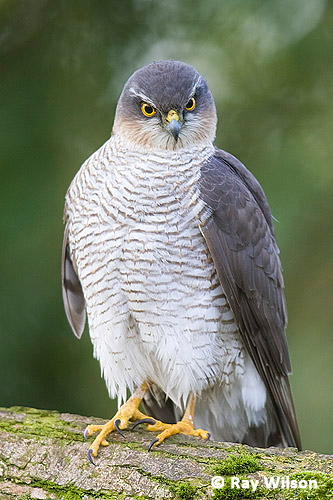Eurasian sparrowhawk
(Accipiter nisus)

Description
It is a small bird with long,rounded wings and a long tail that helps to move between the trees.The tail is always longer than the width of the wings,and inthe adult male it has between four and five wavy bands.Its legs are long and yellow and the tarsus is not wider than the diameter of the eye.Females can be up to 25% larger than males,and twice as heavy.This " reverse sexual dimorphism " is unusual in higher vertebrates,but common among raptors and much more noticeable in ornithopod birds.The adult males measure 29-34 cm in length,with a wingspan of 59-64 cm and a weight of 110-196 g.10 The upper parts are slate gray (in some tends to bluish).On the back there are fine red stripes on a white background that may seem orange in the distance;the iris is yellowish orange or orange red.The female is much larger,with 35-41 cm in length,weighing 185-342 g.10 and a wingspan of 67-80 cm;7 with this size is a little larger than the kestrel and almost equals the young male goshawk.elevenIt has dark brown upper parts and its back is white with gray and brown stripes.The iris is bright yellow to orange,usually covered with a pale superciliary list.December 6 In females is rare note that the stripes on the back are reddish brown and find adult males with lighter stripes.6 The young are cinnamon-colored on top,the coverts on the upper parts have lighter flanks,and have thick stripes or are speckled brown on the bottom,and the bottom of eyes is light yellow.The neck has fragmented dark stripes.The contrast between the light back and the dark upper parts would be an example of Thayer's law (also known as counter shading).n.The "countershading" is observed in raptors that hunt birds and other animals that move quickly.The horizontal stripes of the adults are typical of the birds of prey of the forests,while the bluish coloration of the adult males is also observed in other birds ornitófagas as the peregrine falcon,the merlin and other species of the genus Accipiter.The small beak serves to grab and drag its prey rather than kill or tear it apart.Their long legs and claws are adapted to capture and ingest birds.The outer finger is quite long and thin;the inner and posterior fingers are relatively short and thick.The one in the middle is very long and can be used to grab objects.On the other hand,the protuberance located in the lower part of the leg allows the bird to close it without leaving grooves.
Taxonomic tree:







